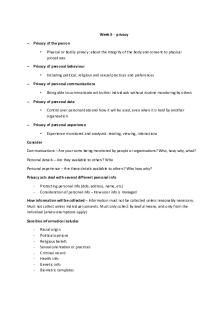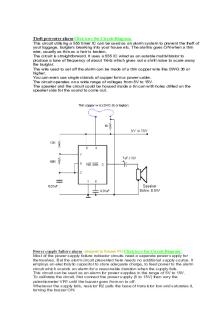ECE 240 - Experiment 9-First Order Circuits PDF

| Title | ECE 240 - Experiment 9-First Order Circuits |
|---|---|
| Author | Roshini Bamunuarachchi |
| Course | Electrical Engineering Fundamentals Lab |
| Institution | California State University Northridge |
| Pages | 10 |
| File Size | 631.7 KB |
| File Type | |
| Total Downloads | 103 |
| Total Views | 148 |
Summary
ECE 240 - Experiment 9-First Order Circuits
build first order circuits that contain a resistor with a capacitor or a resistor with an inductor. We see how voltages of a capacitor or an inductor changes over time by using a function generator as a source of a circuit. Also, in this experiment, ...
Description
Spring 2017
California State University, Northridge Department of Electrical & Computer Engineering
Experiment 9 First Order Circuits
April. 18, 2017
ECE 240L
1. Introduction: In this experiment, we will build first order circuits that contain a resistor with a capacitor or a resistor with an inductor. We see how voltages of a capacitor or an inductor changes over time by using a function generator as a source of a circuit. Also, in this experiment, we will compare a time constants that we got with time constants that we calculated. After that, we compare values that we calculated with values from a measurement.
2. Equipment Used: Type
Model
DC Power Supply
E 3630A
Digital-Multi-Meter (DMM)
CDM250
Serial No.
Calibration Date
Oscilloscope Function Generator Proto-Board 3. Parts Used: QTY
Component
Value
Type
1
Resistor
470Ω
Carbon, +/-5%
1
Resistor
680Ω
Carbon, +/-5%
1
Resistor
6.8KΩ
Carbon, +/-5%
1
Capacitor
0.1μF
Tantalum, +15V
4. Software Used: Pspice Released Version: 16.0.0.s001 MS Office 2010
5. Theory: When we mention first order circuits, we have to know that these circuits contain a capacitor with a resistor or an inductor with a resistor only.
● Voltage-Current for a Capacitor in First-Order Circuit
These formulas above are used to calculate voltage and current passing through a capacitor. C is a capacitance of a capacitor. For a formula 9.1, VC(-∞)=0, so that we can ignore this value so that we can have a formula without Vc(-∞) (9.3).
(9.3) For a DC circuit, a current passing through a capacitor is 0 (short circuit) because dv/dt=0. Because of this condition, a capacitor can be replaced by an open circuit. ● Voltage-Current for an Inductor in First-Order Circuit
(9.4)
(9.5) These formula aboves (9.4) and (9.5) are for an inductor and a resistor in a first-order circuit. For 9.4, voltage is equal L(inductance of a inductor) multiplies by di-L/dt. We assume that Io=0 at the beginning so that we can have another formula for iL (9.6).
(9.6) Under a DC condition, we have a current crossing an inductor is constant so that a voltage passing through an inductor is zero. It is a reason why we can replace an inductor by shorting a circuit under a steady state condition of a circuit. ● Simple RC and RL Circuits ❖ For a RC circuit and RL circuit, we have to consider a value time constants of a capacitor and an inductor. ❖ For a RC circuit, a time constant is て=RC (Unit: second (s)). ❖ For a RL circuit, a time constant is て=L/R (Unit: second(s)). ❖ In DC circuit, it takes 5て (5RC or 5L/R) to fully charge for a capacitor or energize an inductor. 6. Procedure and Results: Circuit 1 ➢ Build the circuit below to find out the internal resistance of the function generator (Rint) ➢ Set the frequency to 2kHz and measure the open circuit voltage. ➢ Then add a 100Ω resistor and measure the voltage.
Results and calculations Voc = 5.12 V
VR = 3.44 V
RL = 100Ω
Rint = RL (Voc - VR) /VR = 100(5.12 - 3.44) / 3.44 = 48.44Ω Rdc=(R/(1-VL))*VL=(100/(1-0.43))*(0.43)=75.44 Ω Circuit 2 Part A ➢ Build the following circuit using R= 470Ω resistor and a capacitor of 0.1μF. ➢ The frequency should be 2kHz square wave of 1Vpp ➢ Record VC(t) using oscilloscope and calculate the time constant.
Results R = 470Ω
With Rint, 5てt = 252μs (Measured) てcalculated= (Rint+R)*C=(48.84Ω+470Ω)*(0.1*10^-6)=5.1884*10^-5 (s) 5てcalculated=259 μs
PSpice data
Part B ➢ Replace the resistor on the previous circuit to a 6.8KΩ and a capacitor of 0.1μF. ➢ Adjust the function generator to an adequate frequency ➢ Record Vc(t) and calculate the time constant. Results R = 6.8kΩ f=800Hz 5てmeasurd=680 µs てcalculated=5てcalculated=(Rint+R)*C=(48.84Ω+6.8*10^3)*(0.1*10^-6)=6.85 µs
PSpice data
Circuit 3 ➢ Build the circuit below with a 680Ω resistor and an 68 mH inductor. Set the wave to 1 Vpp square wave. ➢ Adjust the frequency of the function generator for an adequate value. ➢ Record the voltage and calculate the time constant and compare it with the values from the pre lab.
Results Rdc = {R/(1-VL) }VL = {100/ (1-0.43)} 0.43 Rdc = 75.44Ω てmeasured=600 µs てcalcualted=L/(R+Rint+Rdc)=(680*10^-3)/(680Ω+48.84Ω+75.44Ω)=8.455*10^-5 (s) 5てcalcualted=423 µs
PSpice data
Ak
7. Conclusion: In this experiment we learned to build first order circuits with inductors and capacitors. From these circuits, we know how a capacitor charges and how an inductor energize. Also, we can compare a time constant that we got from a calculation with the one we measured. We believe that we can apply this knowledge to next experiments....
Similar Free PDFs

EXPERIMENT KINETIC ORDER OF REACTION
- 10 Pages

Ece vccs ece scheal
- 3 Pages

Linear Circuits
- 914 Pages

Groups Defined (BHS-240)
- 5 Pages

MATH 240 SYLLABUS
- 2 Pages

240 study notes
- 11 Pages

Parallel Circuits
- 50 Pages

Circuits - Good
- 20 Pages

240 Casos Clinicos - Medicina
- 125 Pages

GCM 240 - Grade: A
- 7 Pages
Popular Institutions
- Tinajero National High School - Annex
- Politeknik Caltex Riau
- Yokohama City University
- SGT University
- University of Al-Qadisiyah
- Divine Word College of Vigan
- Techniek College Rotterdam
- Universidade de Santiago
- Universiti Teknologi MARA Cawangan Johor Kampus Pasir Gudang
- Poltekkes Kemenkes Yogyakarta
- Baguio City National High School
- Colegio san marcos
- preparatoria uno
- Centro de Bachillerato Tecnológico Industrial y de Servicios No. 107
- Dalian Maritime University
- Quang Trung Secondary School
- Colegio Tecnológico en Informática
- Corporación Regional de Educación Superior
- Grupo CEDVA
- Dar Al Uloom University
- Centro de Estudios Preuniversitarios de la Universidad Nacional de Ingeniería
- 上智大学
- Aakash International School, Nuna Majara
- San Felipe Neri Catholic School
- Kang Chiao International School - New Taipei City
- Misamis Occidental National High School
- Institución Educativa Escuela Normal Juan Ladrilleros
- Kolehiyo ng Pantukan
- Batanes State College
- Instituto Continental
- Sekolah Menengah Kejuruan Kesehatan Kaltara (Tarakan)
- Colegio de La Inmaculada Concepcion - Cebu





